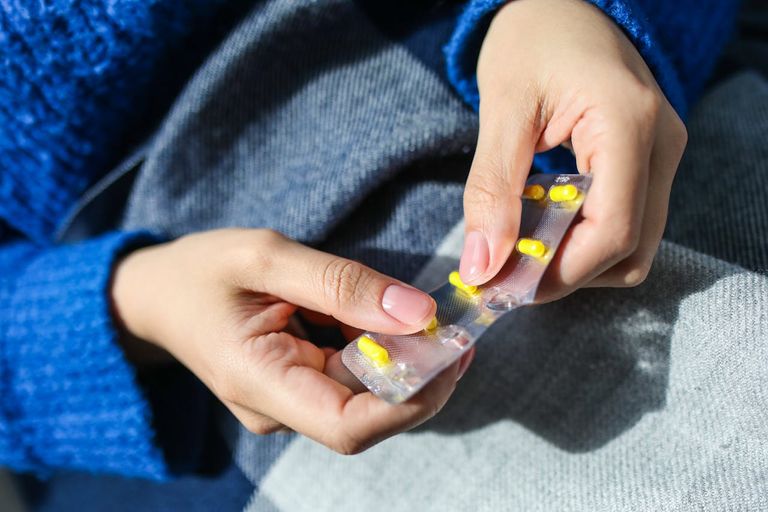
Coughgrip 300mg/15mg/2mg polvo para solucion oral

How to use Coughgrip 300mg/15mg/2mg polvo para solucion oral
Introduction
Leaflet: information for the user
Coughgrip 300 mg/15 mg/2 mgoral powder for solution
Paracetamol / Dextromethorphan hydrobromide/ Chlorphenamine maleate
Read this leaflet carefully before you start taking this medicine, because it contains important information for you.
Follow exactly the administration instructions of the medicine contained in this leaflet or those indicated by your doctor or pharmacist.
- Keep this leaflet, as you may need to read it again.
- If you need advice or more information, consult your pharmacist.
- If you experience adverse effects, consult your doctor or pharmacist, even if they are not listed in this leaflet. See section 4.
- You should consult a doctor if it worsens or does not improve after 3 days.
6.Contents of the pack and additional information
1. What is Coughgrip and what is it used for
Paracetamol / Dextromethorphan / Chlorphenamine is an association of paracetamol, a pain reliever that reduces pain and fever; dextromethorphan, is an antitussive, and chlorphenamine, which helps to reduce nasal secretion.
This medication is indicated for symptomatic relief of colds and flu that are accompanied by mild or moderate pain such as headache, fever, unproductive cough (irritative cough, nervous cough) and nasal secretion in children over 6 years and adolescents.
You should consult a doctor if it worsens or does not improve after 3 days of treatment.
2. What you need to know before starting to take Coughgrip
Do not takeCoughgrip
- If you are allergic to the active ingredients or any of the other components of this medication (listed in section 6)
- If you have a serious liver or kidney disease
- If you have severe respiratory failure or a serious lung disease
- If you have asthma or a cough with excessive mucus production
- If you are currently or have recently been treated with other medications, such as antidepressants, Parkinson's disease medications, or medications for other conditions (monoamine oxidase inhibitors (MAOIs), selective serotonin reuptake inhibitors (SSRIs) such as fluoxetine or paroxetine, or bupropion, a smoking cessation medication, or linezolid, an antibiotic (see section "Other medications and Coughgrip"))
- Children under 6 years old cannot take this medication.
Warnings and precautions
Consult your doctor or pharmacist before starting to take Coughgrip
- Do not take more medication than recommended in section 3. How to take Coughgrip
- Chronic alcoholics should be careful not to take more than 6 packets per day (2g of paracetamol)
- Avoid taking this medication with other medications that contain paracetamol, as high doses can cause liver damage. Do not take more than one medication containing paracetamol without consulting your doctor.
- Inform your doctor if you have a G6PD deficiency (can cause hemolytic anemia)
Consult your doctor or pharmacist before starting to take this medication, the following patients:
- Patients with persistent or chronic cough, such as that caused by smoking. In children, chronic cough may be an early sign of asthma
- Patients with kidney, heart, or lung diseases, and patients with anemia
- Patients with liver diseases (with or without liver insufficiency) or viral hepatitis, as it increases the risk of hepatotoxicity due to paracetamol
- Asthmatic patients sensitive to acetylsalicylic acid
- Patients allergic to antihistamines, as they may be sensitive to other antihistamines (such as chlorphenamine)
- Patients with hypertension (elevated blood pressure), glaucoma (elevated intraocular pressure), hyperthyroidism, urinary obstruction, benign prostatic hyperplasia, urinary retention
- Older patients who may be more sensitive to the side effects of this medication
- Patients who are sedated, debilitated, or bedridden
- Patients with atopic dermatitis (inflammatory skin disease characterized by erythema, pruritus, exudation, crusts, and desquamation, which begins in childhood in individuals with hereditary allergic predisposition)
Inform your doctor immediately during treatment with Coughgrip:
- If you have severe diseases, such as severe renal insufficiency or sepsis (when bacteria and their toxins circulate in the blood, causing damage to organs), or if you have malnutrition, chronic alcoholism, or if you are also taking flucloxacillin (an antibiotic). A severe disease called metabolic acidosis (a blood and fluid anomaly) has been reported in patients in these situations when using paracetamol at regular doses for a prolonged period or when taking paracetamol with flucloxacillin. Symptoms of metabolic acidosis may include: severe respiratory distress with deep and rapid breathing, somnolence, feeling unwell (nausea), and vomiting.
This medication causes sedation. Avoid consuming alcoholic beverages and certain medications while taking this medication, as they may potentiate this effect. See sections "Other medications and Coughgrip" and "Taking Coughgrip with food, drinks, and alcohol".
Cases of abuse with dextromethorphan-containing medications have been reported in adolescents, so this possibility should be taken into account, as it may cause severe adverse effects (see section: If you take more Coughgrip than you should).
This medication may be addictive, so its use at high doses or for a prolonged period may cause mental and physical dependence. In patients with a tendency to abuse or dependence, it should only be administered under strict medical control and for short periods of time.
This medication may cause dependence. Therefore, treatment should be of short duration.
Other medications and Coughgrip
Inform your doctor or pharmacist if you are taking, have taken recently, or may need to take any other medication.
You cannot take this medication if you are being treated with the following medications, or in the 2 weeks following them, as it may cause excitement, high blood pressure, and fever above 40°C (hyperpyrexia):
- monoamine oxidase inhibitors (MAOIs) (moclobemide, tranilcipromine)
- selective serotonin reuptake inhibitors (SSRIs) (paroxetine, fluoxetine)
- bupropion (used for smoking cessation)
- linezolid (used as an antibacterial)
- procarbazine (used to treat cancer)
- selegiline (used to treat Parkinson's disease)
If you are using any of the following medications, consult your doctor before starting to take this medication, as it may be necessary to modify the dose of some of them or interrupt treatment:
- Medications for epilepsy: antiepileptics (lamotrigine, phenytoin, or other hydantoins, phenobarbital, metharbital, primidone)
- Medications for tuberculosis: isoniazid, rifampicin
- Medications to prevent blood clots: oral anticoagulants (acenocoumarol, warfarin)
- Medications used to increase urine production: diuretics of the loop type, such as furosemide, or other diuretics that cause potassium loss, such as diuretics for hypertension or other conditions
- Medications used to prevent nausea and vomiting: metoclopramide and domperidone
- Medications used to treat gout: probenecid
- Medications used to treat high blood pressure: propranolol and arrhythmias: amiodarone or quinidine
- Medications used to lower cholesterol levels in the blood: cholestyramine
- Medications used to treat depression: moclobemide, tranilcipromine, fluoxetine, paroxetine, bupropion, selegiline, or other medications for other conditions, such as cancer (procarbazine), infections (linezolid, furazolidine). The administration of Coughgrip should be separated from these medications by at least 14 days after completing treatment
- Other medications for depression, known as tricyclic and tetracyclic antidepressants (such as maprotiline)
- Medications for schizophrenia: haloperidol
- Medications that cause depression of the central nervous system (such as those used for insomnia or anxiety, for Parkinson's disease, or for allergies)
- Medications ototoxic (that can damage the ear)
- Medications photosensitizing (that can cause an allergic reaction to light)
- Medications used to relieve pain and inflammation: celecoxib, parecoxib, valdecoxib
- Medications used to increase mucus production
- Flucloxacillin (antibiotic), due to a serious risk of blood and fluid anomaly (called metabolic acidosis) that requires urgent treatment (see section 2)
Interference with diagnostic tests:
If you are to undergo any diagnostic test (including blood, urine, skin tests using allergens, etc.), inform your doctor that you are taking this medication, as it may alter the results.
Consult your doctor or pharmacist before taking Coughgrip:
If you are taking other medications, such as antidepressants or antipsychotics, Coughgrip may interact with these medications and you may experience changes in your mental state (e.g., agitation, hallucinations, coma) and other effects such as high body temperature, increased heart rate, high blood pressure, and exaggerated reflexes, muscle rigidity, lack of coordination, and/or gastrointestinal symptoms (e.g., nausea, vomiting, and diarrhea).
Taking Coughgrip with food, drinks, and alcohol
While taking this medication, you cannot consume alcoholic beverages, as they may potentiate the appearance of adverse effects of this medication.
Additionally, the use of paracetamol-containing medications by patients who regularly consume alcohol (3 or more alcoholic beverages: beer, wine, liquor, etc. per day) may cause liver damage.
You should not take the medication with orange or grapefruit juice, as it may potentiate the effects of one of its components (dextromethorphan).
The rest of the foods and drinks can be taken with this medication, as they do not affect its efficacy.
Pregnancy, lactation
If you are pregnant or breastfeeding, or if you think you may be pregnant, consult your doctor or pharmacist before using this medication.
This medication should not be taken during pregnancy or lactation without consulting your doctor
Driving and operating machinery
This medication may cause drowsiness, affecting your mental and/or physical abilities. If you experience these effects, avoid driving vehicles or operating machinery.
Coughgrip contains saccharose and sodium:
This medication contains saccharose. If your doctor has told you that you have an intolerance to certain sugars, consult with them before taking this medication.
This medication contains less than 23mg of sodium (1mmol) per sachet; it is essentially "sodium-free".
3. How to Take Coughgrip
Follow exactly the medication administration instructions contained in this leaflet or those indicated by your doctor or pharmacist. In case of doubt, ask your doctor or pharmacist.
Paediatric population
Severe adverse effects may occur in children in case of overdose, including neurological alterations. Caregivers must not exceed the recommended dose..
The powder contained in the Coughgrip sachets is for oral administration.
The recommended dose is:
Children aged 6 to 12 years (weight between 21.5 kg and 43 kg):1 sachet every 6-8 hours as needed (3 or 4 times a day).
Over 12 years old (weight over 44 kg):2 sachets every 6-8 hours (3 or 4 times a day) as needed.
Preferably take 1 dose before going to bed. Do not exceed 4 doses.
This medication is contraindicated in children under 6 years.
Always use the lowest effective dose.
Start treatment as soon as the first symptoms appear and discontinue as they disappear.
The medication must not be used for more than 3 consecutive days without consulting a doctor (see section 1 What is Coughgrip and what is it used for).
How to take:
This medication is taken orally.
Empty the contents of one sachet into a half glass of water and stir vigorously. Take immediately.
If you take moreCoughgripthan you should
Go immediately to a medical centre, even if there are no symptoms, as they often do not appear until 3 days after ingestion of the overdose, even in cases of severe poisoning.
The most severe effect of medication overdose is liver damage caused by paracetamol. You may feel dizziness, vomiting, confusion, excitement, restlessness, nervousness, irritability, visual disturbances, loss of appetite, yellowing of the skin and eyes (jaundice), abdominal pain and difficulty breathing. In children, states of somnolence, nervousness, nausea, vomiting or gait disturbances may occur.
The treatment of overdose is more effective if initiated within 4 hours of medication ingestion.
Patients undergoing barbiturate treatment or chronic alcoholics may be more susceptible to the toxicity of a paracetamol overdose.
Cases of abuse with medications containing dextromethorphan have been reported, which may lead to severe adverse effects, such as: anxiety, panic, memory loss, tachycardia (rapid heartbeat), lethargy, hypertension or hypotension (high or low blood pressure), mydriasis (pupil dilation), agitation, vertigo, gastrointestinal disturbances, mumbling speech, nystagmus (uncontrolled and involuntary eye movements), fever, tachypnea (rapid and shallow breathing), brain damage, ataxia (uncoordinated movements), convulsions, respiratory depression, loss of consciousness, arrhythmias (irregular heartbeat) and death.
In case of overdose or accidental ingestion, consult your doctor or pharmacist immediately or call the Toxicological Information Service, phone: 91 562 04 20, indicating the medication and the amount taken. It is recommended to bring the packaging and the leaflet to the healthcare professional.
If you take more Coughgrip than indicated, you may experience the following symptoms: nausea and vomiting, involuntary muscle contractions, agitation, confusion, drowsiness, disturbances of consciousness, involuntary and rapid eye movements, cardiac disturbances (rapid heart rate), coordination disturbances, psychosis with visual hallucinations and hyperexcitability.
Other symptoms in case of massive overdose may be: coma, severe respiratory problems and convulsions.
Overdose may also cause: coagulation disorders (blood clots and bleeding).
Immediately contact your doctor or hospital if you experience any of the mentioned symptoms.
4. Possible Adverse Effects
Like all medications, this medication may produce adverse effects, although not all people may experience them.
The most frequent adverse effects are drowsiness and drowsiness.
During the period of use of the paracetamol, dextromethorphan, and chlorpheniramine association, the following adverse effects have been produced whose frequency has not been established with precision.
Rarely, nightmares, insomnia, excitement, nervousness, or restlessness (psychomotor hyperactivity) may occur, more common in children and the elderly. Dizziness and hypotension, especially in the elderly.
Very rarely, gastrointestinal discomfort, such as abdominal pain, diarrhea, nausea, vomiting, and indigestion (dyspepsia), confusion, dizziness, visual disturbances, increased sensitivity to the sun, dry mouth, sore throat, and difficulty urinating. Skin eruptions, severe skin reactions, and severe allergic reactions, such as anaphylactic reaction, hypersensitivity, angioedema (swelling of certain areas of the skin), pruritus, urticaria, rash, allergic dermatitis, as well as increased transaminases have also been described. High doses or prolonged treatment are toxic to the liver.
Unknown frequency (cannot be estimated from available data): A serious disease that can make the blood more acidic (designated metabolic acidosis) in patients with serious disease who use paracetamol (see section 2).
Other Adverse Effects in Children
The taking of very high amounts of this medication may produce in children a state of drowsiness, nervousness, nausea, vomiting, or alterations in the way of walking.
The simultaneous consumption of alcohol during treatment may accentuate the appearance of adverse effects. Do not consume alcoholic beverages during treatment.
Reporting of Adverse Effects
If you experience any type of adverse effect, consult your doctor or pharmacist, even if it is a possible adverse effect that does not appear in this prospectus. You can also report them directly through the Spanish System for Pharmacovigilance of Medicines for Human Use:www.notificaRAM.es.By reporting adverse effects, you can contribute to providing more information on the safety of this medication.
5. Conservation of Coughgrip
Keep this medication out of the sight and reach of children.
Do not use this medication after the expiration date that appears on the packaging, after CAD. The expiration date is the last day of the month indicated.
No special storage conditions are required
Medications should not be disposed of through drains or in the trash. Deposit the packaging and medications you no longer need at the SIGRE point of the pharmacy. Ask your pharmacist how to dispose of the packaging and medications you no longer need. This way, you will help protect the environment.
6. Contents of the packaging and additional information
Composition ofCoughgrip
Each sachet contains:
- The active principles are: 300 mg of paracetamol, 15 mg of dextromethorphan (as hydrobromide) and 2 mg of chlorphenamine (as maleate).
- The other components (excipients) are: anhydrous colloidal silica, anhydrous citric acid, sucrose, sodium saccharin, anhydrous sodium cyclamate, orange flavor.
Appearance of the product and contents of the packaging
Coughgripis a white or off-white powder for oral solution with orange flavor, presented in sachets that are packaged in cardboard boxes with 10 sachets.
Holder of the marketing authorization and responsible for manufacturing
Holder of the marketing authorization
Tecnimede España Industria Farmacéutica, S.A.
Avda. de Bruselas, 13. 3º D
28108 Alcobendas (Madrid)
Spain
Responsible for manufacturing
Laboratorios Alcalá Farma, S.L.
Avenida de Madrid, 82
28802 Alcalá de Henares Madrid
Spain
Last review date of this leaflet:February 2025
The detailed and updated information on this medicine is available on the website of the Spanish Agency for Medicines and Medical Devices (AEMPS)http://www.aemps.gob.es/
- Country of registration
- Active substance
- Prescription requiredNo
- Manufacturer
- CompositionSacarosa de compresion (1937 mg mg), Ciclamato de sodio (140 mg mg)
- This information is for reference only and does not constitute medical advice. Always consult a licensed doctor before taking any medication. Oladoctor is not responsible for medical decisions based on this content.
Ask a doctor about Coughgrip 300mg/15mg/2mg polvo para solucion oral online
Talk to a doctor online
Need help understanding this medicine or your symptoms? Online doctors can answer your questions and offer guidance.















